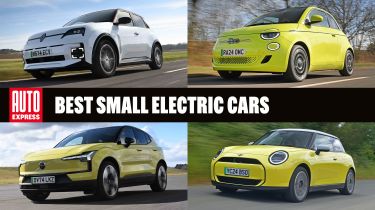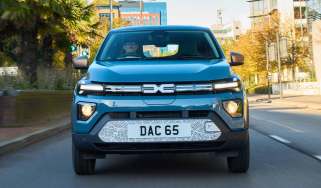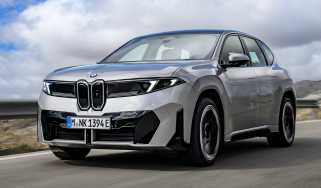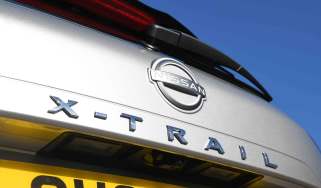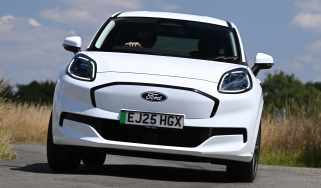Best small electric cars to buy 2025
These compact electric cars offer colossal efficiency
Small cars are a firm favourite in the UK; they perfectly suit our cosy country roads, as well as the increasingly congested streets in our towns and cities. The best small electric cars offer the same levels of driving agility and ease, but with the added benefits of zero emissions and even lower running costs.
You could argue that electric cars make most sense when used for short trips in urban areas. Assuming that you have somewhere to charge at home or at a place of work, a small EV with a range of around 200 miles is a fantastic option as a low mileage first or second car. Even if you can’t charge at home, you might only need to find a public charging point once a week or so, with the kind of ranges currently on offer.
Beyond that, the brisk acceleration, near silent running and beautifully simple driving experience all make these small electric cars very attractive. Whatever your requirements, our expert road testers have rounded up the top ten small electric cars you can buy right now, based on our extensive real-world test results.
Compare the best small electric cars
| Best small electric car ranking | Model | Overall Auto Express star rating (out of 5) | Prices from | Max. WLTP combined range |
| 1 | Renault 5 | 4.5 | £23,000 | 250 miles |
| 2 | Fiat Grande Panda | 4.5 | £21,000 | 199 miles |
| 3 | Citroen e-C3 | 4.5 | £22,100 | 199 miles |
| 4 | Volvo EX30 | 4.5 | £31,600 | 296 miles |
| 5 | BYD Dolphin | 4 | £30,200 | 265 miles |
| 6 | Leapmotor T03 | 4 | £16,000 | 165 miles |
| 7 | Hyundai Inster | 4 | £23,500 | 229 miles |
| 8 | Dacia Spring | 3.5 | £15,000 | 140 miles |
| 9 | MINI Cooper | 4 | £26,900 | 250 miles |
| 10 | Fiat 500e | 3.5 | £25,000 | 199 miles |
Keep reading to see the best small electric cars to buy or click the links above to go straight to each individual car
1. Renault 5
- Prices from £23,000
- WLTP combined battery range: up to 250 miles
Pros |
Cons |
|
|
Small cars, electric or otherwise, don’t come much more stylish than the Renault 5.
Luckily, the 5 has more to it than just good looks. It’s also priced well, starting at around £23,000 for a 118bhp, 40kWh car in Evolution trim, and topping out with a 148bhp, 52kWh model in range-topping Iconic Five spec. We think the sweet spot is somewhere in the middle: Techno trim with the punchier motor and larger battery (which come as a pair), as you’ll get the quicker 7.9-second 0-62mph time and larger 250-mile claimed range without forking out as much money.
Whichever variant you pick, the Renault 5 is a fine all-rounder in terms of the driving experience. Smooth power delivery means there’s no unpleasant lurching, while the light and direct steering means you can have a decent amount of B-road fun. All of the usual small car qualities are present, too, including a tight turning circle and plenty of all-round visibility. One slight quirk is the lack of a ‘park’ gear, but it didn’t take too long for our road testers to get used to this.
The 5 is also a practical car by supermini standards. There’s just enough space for four adults inside, while the 326-litre boot will happily take on a sensibly-sized weekly shop. Every trim level is also generously equipped, and we’re big fans of Renault’s Google-based infotainment software; it looks great, functions quickly and is easy to operate.
Those who enjoy the charms of a retro car have an increasing amount of choice on the EV market. The closely-related Renault 4 shares a lot of components with the 5, but with a slight advantage in terms of practicality. There’s also the MINI Cooper Electric to consider, although this is pricier than the Renault.
"Renault has engineered a feeling of solidity into the way that the 5 behaves on the road. In terms of refinement and stability, it really doesn’t feel like a small car at all. It’s all very grown up and reassuring." - Alex Ingram, chief reviewer
2. Fiat Grande Panda
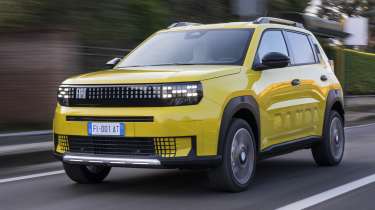
- Prices from £21,000
- WLTP combined battery range: up to 199 miles
Pros |
Cons |
|
|
The Renault 5 has proved that a resurrected people’s car can be successful, and now the Fiat Grande Panda has arrived to cash in on this fledgling part of the EV market.
While it’s available in both hybrid and electric forms, it’s the latter we’re focusing on here. The latest iteration of Fiat’s long-standing small car is much more distinctive to behold than ever before, but it still maintains its crucial simplistic and low-cost ethos underneath. Every electric Grande Panda is fitted with a 44kWh battery that returns up to 199 miles on the WLTP Combined cycle. In an exclusive Auto Express experiment where we drove budget EVs until they completely ran out of charge, the Panda managed to cover 134 miles before hitting zero per cent. This isn’t a huge number by today’s standards, but it should still prove more than enough for most drivers’ daily needs.
The old Pandas were often used as deceptively small family cars, and while the ‘Grande’ aspect of this car does result in a reasonable level of practicality. 361 litres of boot space doesn't make this Fiat a class leader in this regard, but this is combined with some useful storage solutions elsewhere as well as an innovative coiled charging cable. Passenger space is a bit snug for longer journeys, but you’ll be able to ferry around taller occupants thanks to the boxy shape.
It’s still pretty no-frills, but the Grande Panda’s interior is still a far cry from its ancestors. While the materials are very budget-focused, Fiat’s engineers have done a great job of hiding this fact. There’s a pleasing amount of colour splashes, too, along with a dual-screen dashboard layout. It doesn’t feel quite as fancy as a Renault 5 inside, but it’s important to remember that the Fiat is cheaper to buy.
Speaking of the Renault 5, that car is one of the Panda’s most direct rivals. However, there’s also a competitor that resides a little bit closer to home’ the Citroen e-C3. This former Auto Express Car of the Year is arguably a bit less characterful than the Fiat, but it offers a very similar level of sheer value for money.
“The Grande Panda rides remarkably well considering its short wheelbase. Even over the cruddy roads of central Turin that we experienced, the Panda never crashed into potholes or speed humps.” - Jordan Katsianis, senior staff writer
3. Citroen e-C3
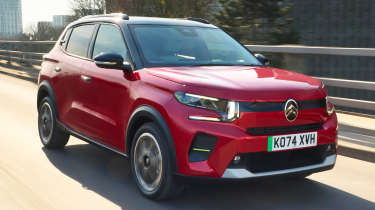
- Prices from £22,100
- WLTP combined battery range: up to 199 miles
Pros |
Cons |
|
|
The Citroen e-C3 is a former Auto Express Car of the Year award winner for good reason. As well as being a talented little car in its own right, it was also a sign that the small EV market is becoming more accessible than ever.
The e-C3 starts at under £22,000, and it offers a refreshingly straightforward approach to fully electric motoring. Rather than going all-out with flashy tech and gimmicks, Citroen has opted to build a simplistic supermini that just so happens to be an EV. It’s still a pretty funky car to look at but there are of course some compromises at this level, although not as many as you get with the tinier and cheaper Dacia Spring or Leapmotor T03. You can’t get an e-C3 with a heat pump for instance, so the official 198-mile range is subject to the ambient temperature.
On the other hand, though, the ride quality and squashy seats make the e-C3 comfortable even on poorly surfaced roads. Performance certainly isn’t the most brisk with a 0-62mph of 11 seconds, but this Citroen is very easy to drive. In other words, this is a car that meets the sensible requirements. Some carefully thought out design work means there’s a fair amount of space inside, too, and the tall body makes the e-C3 easy to get in and out of.
The theme of simplicity continues when it comes to standard features, but you’ll still find the typical mod cons including a 10.25-inch touchscreen and air-conditioning. Our testers were pleased to find a number of proper buttons and rotary dials, too.
Those who crave simplicity have a few electric cars to choose from along with the Citroen e-C3. The Leapmotor T03 and Dacia Spring follow a similarly basic formula, but both of these cars are much smaller than the Citroen. The closely-related Fiat Grande Panda offers many of the same plus points as the e-C3, but with a few unique touches and brighter design tweaks.
“The high driving position makes it easy to see out - especially from the front seats - and light steering makes it easy to twirl the wheel as you move in and out of tight spots.” - Alex Ingram, chief reviewer
4. Volvo EX30
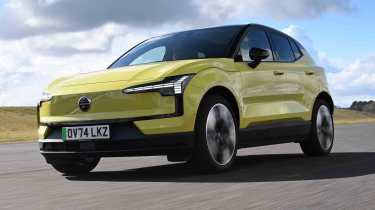
- Prices from £31,600
- WLTP combined battery range: up to 296 miles
Pros |
Cons |
|
|
It’s pretty unheard of for a plush SUV to fall within a similar price bracket to much smaller and more barebones cars, but the Volvo EX30 has somehow managed it.
It’s not exactly the cheapest car on this list with its starting price of around £31,600, but the EX30 is easily one of the most upmarket cars you’ll manage to bag for this kind of money. As well as the badge appeal, our road testers couldn’t help but be impressed by the sheer level of comfort offered by this baby electric SUV, and an official battery range of up to 296 miles isn’t too shabby, either.
The EX30 is deceivingly quick, too, with a 0-62mph time of as low as 3.6 seconds. We’re willing to bet that few people are buying an electric Volvo for outright performance, though, so we’re also pleased to report that this one is a breeze to drive and remains nice and quiet at motorway speeds. Don’t expect much in the way of road-going excitement, though, this is still a sensible family car at heart, regardless of its seriously brisk acceleration.
It’s inside the EX30 where you’ll find one potential dealbreaker, and that is this car’s heavy dependence on its 12.3-inch central touchscreen. Nearly every single function, including door mirror adjustment, is operated via the infotainment system, and this was the cause of the occasional frustration during testing. If you’re a fan of minimalism and an embracer of tech, though, the cabin is a pleasant and well-built place to be.
You’re probably all too well aware of the abundance of electric SUVs that have arrived on the market, so the Volvo EX30 has its work cut out. The DS 3 E-Tense, Peugeot E-2008 and Alfa Romeo Junior all offer a bit of a prestige feel as well as fully-electric powertrains, but they simply can’t beat the Volvo on price.
“The Volvo’s punchy electric powertrain provides strong performance off the line and from low speeds, so you’ll never want for more power around town. The Swedish EV also deals with potholes and bumps pretty well.” - Alex Ingram, chief reviewer
5. BYD Dolphin
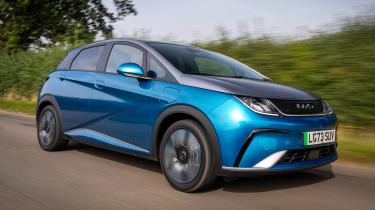
- Prices from £30,200
- WLTP combined battery range: up to 265 miles
Pros |
Cons |
|
|
China has carved out a niche for itself in the European market, offering great-value electric cars that mix size, equipment and price in a way more familiar brands sometimes struggle to match. The BYD Dolphin is one of those cars.
Unfortunately, the Dolphin’s starting price has crept upwards over time to £30,000+, but it is still an appealing package. For this money you’ll get a 60.4kWh battery pack that’s good for 265 miles. One area where the Dolphin lags a bit behind the competition is with its rapid charging speed, as a maximum 88kW peak capacity means a 10 to 80 per cent top-up takes around 41 minutes. In comparison, the MG4 will be done and dusted in just 24 minutes at a speed of 142kW.
Brand-new Dolphins also come exclusively with a 201bhp motor and seven-second 0-62mph time, but don’t expect any fireworks from the driving experience – the relatively soft suspension that soaks up bumps admirably in town means the Dolphin is unsettled on a country road.
The Dolpin’s interior offers the BYD quirkiness that we’ve come to expect, with quite an organic look to the dashboard, reasonable quality and a rotating touchscreen infotainment system. When you’re not playing “screen goes up, screen goes down”, it functions pretty well, and the Dolphin’s near-monobox shape means plenty of interior space and a decent 345-litre boot.
As we briefly mentioned, the MG4 is another competitively-priced Chinese electric hatchback (it’s actually a little bit cheaper than the BYD). Alternatively, those in the market for a smaller zero-emission family car may also want to look towards the Volkswagen ID.3 or Renault 5.
“You can easily provoke wheelspin from the 201bhp powertrain if you press the pedal too hard from a standing start, but this doesn’t really mean it’s all that much fun. Instead, it’s just a useful amount of additional power to help get up to speed faster when needed.” - Shane Wilkinson, senior content editor
6. Leapmotor T03
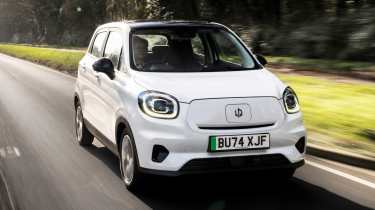
- Prices from £16,000
- WLTP combined battery range: up to 165 miles
Pros |
Cons |
|
|
Electric cars are expensive, right? Well, every rule has its exceptions, and the Leapmotor T03 bucks the trend of EVs costing far more than combustion-engined cars.
A starting price of around £16,000 means the T03 costs a fraction more than the similar Dacia Spring, but otherwise this is still one of the cheapest cars anywhere on the market, let alone among EVs. The reason we’ve picked the Leapmotor over the Dacia is because it offers just that bit more value for money. As well as a slightly longer claimed battery range of 165 miles, the Leapmotor is also a bit more powerful with 95bhp and 158Nm of torque on tap. 45kW charging is pretty speedy for an EV of this size and price, too.
As you can probably tell, this car is no speed machine, but the T03 offers plenty of all-round visibility thanks to its tall stance and driving position. This quickly comes in very useful when driving around the hectic city streets. The little Leapmotor didn’t feel too out of its depth when we hit the motorways, either, and it even managed to take on the occasional overtake without running out of puff.
Another area where the Leapmotor has a slight advantage over the Dacia is inside, as the cabin feels just a teensy bit plusher. Every variant is respectably equipped, and you don’t have to fork out extra cash in order to bag the 10-inch touchscreen. This infotainment system takes a bit of getting used to, but it’s perfectly ok when taking the car’s price into consideration. We did find the safety system warning chimes to be a bit overenthusiastic, though, and these soon became rather tedious.
There aren’t many electric cars that currently come close to the Leapmotor T03’s £16,000 starting price, but there are two options that make the grade. The Dacia Spring undercuts the T03 by around £1,000 but you’ll have to make do with a decreased 140 mile claimed battery range. Alternatively, the BYD Dolphin Surf can cover a similar number of miles for just shy of £19,000
7. Hyundai Inster
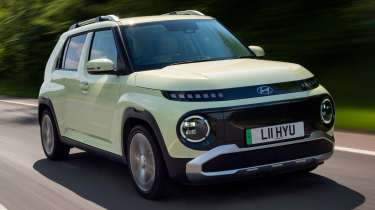
- Prices from £23,500
- WLTP combined battery range: up to 229 miles
Pros |
Cons |
|
|
It isn’t an Ioniq, but the Hyundai Inster still follows a very similar formula of combining sci-fi looks with plenty of practical touches.
The Inster is one of Hyundai’s cheaper electric offerings, but it still offers a healthy official battery range of up to 229 miles. When we pitted this little EV against the similarly groovy Renault 5, the Inster returned an average of 4.0 miles per kWh, which equates to around 196 miles. This is a pretty admirable real-world figure considering that our testing took place over a wide variety of roads and speeds.
The Hyundai’s tall stature means it suffers from its fair share of wind noise when it gets up to speed, and there’s plenty of body roll in the corners. Aside from these setbacks, though, the Inster is comfortable to sit in, and its generally compact dimensions mean narrow roads and parking spaces are rarely a concern.
Take a peek at the dashboard and you’ll see that Hyundai hasn’t been afraid to adorn the Inster with proper buttons. The 10.25-inch touchscreen doesn’t feature the Korean brand’s latest software (an indicator of the Inster’s lower price), but it still gets the job done. We couldn’t help feeling that the screen was a tad too high to reach, though.
Eye-catching EVs are arriving at a steady rate, so the Hyundai Inster has an increasing number of models to contend with. The Renault 4, Renault 5, Fiat 500e, Fiat Grande Panda and Citroen e-C3 are just some of the more distinctive electric cars you can now buy, and they all offer some pretty tempting prices and finance deals.
“Its slim figure makes you feel like you can thread the Inster through any gap in traffic or sneaky side road you fancy. Although its decent motorway manners mean you needn’t feel confined to only city driving.” - Ellis Hyde, senior news reporter
8. Dacia Spring
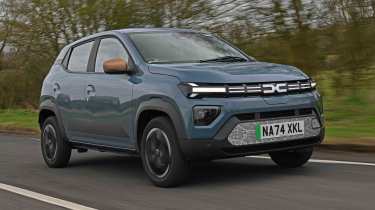
- Prices from £15,000
- WLTP combined battery range: up to 140 miles
Pros |
Cons |
|
|
Dacia is one of the last holdouts of truly affordable motoring, so it’s no surprise that its first electric car, the Dacia Spring, is the cheapest ‘proper’ electric car you can buy.
The Spring starts at around £15,000, and even if you’re completely reckless with the options list on the top-spec, more powerful model, it’s still impossible to spend more than £20,000. The key difference between the Expression and Extreme trim levels is the standard kit, as both versions are powered by the same 26.8kWh battery pack. This means both will cover up to 140 miles on the WLTP combined cycle. This isn’t exactly much on paper, but it should still be enough for daily city driving needs.
Along with the 26.8kWh battery pack, the entry-level Spring Expression has 44bhp and 64bhp electric motor options, while the range-topping Extreme only gets the 64bhp motor. You’ll probably want that sprightlier model, as this trims the 0-62mph time down from a yawning 19.1 seconds to a comparatively white-knuckle 13.7 seconds. Either way, the Spring is happier at urban speeds than on motorway blasts. For simply pootling about, though, this car is cheap, easy and refreshingly simplistic.
The Spring’s small size and bargain basement price compromise things such as rear legroom or the quality of the plastics surrounding you, and the doors close with a bit of a clang. You’ll need to cough up a bit of extra money for the 10.1-inch touchscreen, but this does add ever-useful Apple CarPlay and Android Auto Connectivity.
No brand-new ‘proper’ electric car is cheaper to buy than the Dacia Spring, but if you’re only covering a few miles a day, the Citroen Ami quadricycle costs less than £8,000. You will need to live under 50 miles per charge, though. If you want a fully-sized EV for under £20,000, the Leapmotor T03 and BYD Dolphin Surf are two of the more competitive choices.
“While the steering is a little sticky around straight ahead, it’s very light, and the 9.63-metre turning circle is brilliant in tight spots. The ride is fairly soft, and despite the short wheelbase, the Spring isn’t too bouncy, either.” - Alex Ingram, chief reviewer
9. MINI Cooper

- Prices from £26,900
- WLTP combined battery range: up to 250 miles
Pros |
Cons |
|
|
The electric MINI is now technically in its third generation, and the brand’s experience has been utilised to ensure that this latest model hits the mark.
This time called the MINI Cooper, it’s available in 181bhp, 36.6kWh Cooper E and 215bhp, 49.2kWh Cooper SE versions – plus a 258bhp and 49.2kWh John Cooper Works Electric Sport model. The look is all new (or at least, as new as a design with its roots in the 1950s can be considered) and it’s still pretty pokey in the back seats and the boot, but the peppy performance and fun handling are still present and correct.
That’s just as well, because this MINI falls down on the value side somewhat. You’ll pay around £27k for an entry-level Cooper E in Classic trim with a 185-mile range. This makes the £23k, 193-mile Renault 5 E-Tech look like a bargain. If you want a more competitive 250-mile range, the cheapest Cooper SE is much closer to £30,000. Expense aside though, the MINI remains a desirable product, electric or not.
Inside, parent company BMW’s influence can be found in abundance as the cabin is adorned with a number of top-shelf materials. The design is as unique as ever, too, while the circular central screen uses OLED technology to look extra vivid. There’s just about enough space inside for four adults to get comfortably seated.
The Renault 5 is one of the electric MINI’s biggest rivals thanks to its similar old-school charm, and this car also costs a good few thousands less to buy. If you want to save even more pennies, the Fiat Grande Panda EV starts from around £21,000.
“Approach a corner quickly, and the front end tucks in nicely; there’s excellent lateral grip and minimal body roll, so if you’ve enjoyed hugging the inside of a corner in your petrol-powered MINI over the years, you can do the same here.” - John McIlroy, Auto Express contributor
10. Fiat 500e
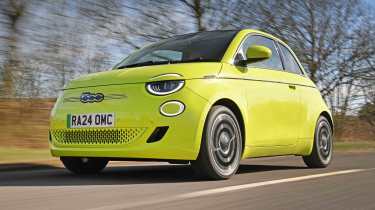
- Prices from £25,000
- WLTP combined battery range: up to 199 miles
Pros |
Cons |
|
|
A smooth, silent, zero-emission powertrain makes perfect sense in a city car, and Fiat clearly had the same brainwave as the latest iteration of the 500 is available as a fully-fledged EV.
The entry-level 500 only has an official 118 mile range thanks to its 24kWh battery, so we recommend springing for the larger 42kWh pack. This boosts the dinky EV’s claimed range up to a much more ideal 193 miles. Small batteries also mean quick charging times, and a 10 to 80 per cent top-up from most rapid chargers takes just half an hour.
While the 500 is just about capable of handling shorter motorway trips, it’s in the sprawling chaos where this car really shines. It’s easy to park, the steering is light, the ride is comfortable for a car of this class, and it’s capable of one-pedal driving. If you want to feel the wind in your hair there’s the option of a convertible called the 500c. You could also opt for the souped-up Abarth 500e with 150bhp on tap.
Hop inside the Fiat and, no matter which trim level you choose, you’re greeted by a thoroughly modern cabin featuring tech like a 10.25-inch central touchscreen, Apple CarPlay, Android Auto and a fully digital driver’s display. The 500 also has level 2 autonomous driving capabilities – this allows the car to adjust acceleration and braking while remaining within its designated lane.
Just like it was in the 1960s, the modern Fiat 500 still has to face the mighty MINI in the battle for nostalgic supremacy. The MINI is bigger than the Fiat, but it’s also much more expensive. Move a bit closer to home and the Fiat Granda Panda is another strong contender in the budget EV world.
“Being a city car, it’s at low speed where the 500e is designed to excel – and it does. Great visibility, tiny dimensions and a tight turning circle make everything from parking to darting in and out of traffic a doddle.” - Alex Ingram, chief reviewer.
How we choose the best small electric cars
Small cars have long been associated with equally miniature running costs, and our exclusive Auto Express car buyer research only proved this further as a whopping 55.1 per cent of small car buyers prioritised value for money above all else when choosing a car. Our experts always have a car buyer’s needs in mind when conducting our in-depth road testing, so we pay very close attention to just how much bang for buck you’ll truly get from every small electric car on sale in the UK.
A generous helping of standard kit, sensible real-world battery range, tempting starting price and useful practicality all go a long way towards pushing a small electric car towards the top of this list. There’s no harm in a bit of fun, though, so a pleasant driving experience and punchy performance are two further factors that influence a car’s final score.
Of course, when it’s time to recharge, you don’t want to be sitting around twiddling your thumbs for ages, so we also find out whether an EV’s charging time matches a manufacturer’s claims on paper. The quicker the car is topped up, the happier our road testers are.
Hunting for a bargain? These are the cheapest electric cars...
Best small electric car deals

